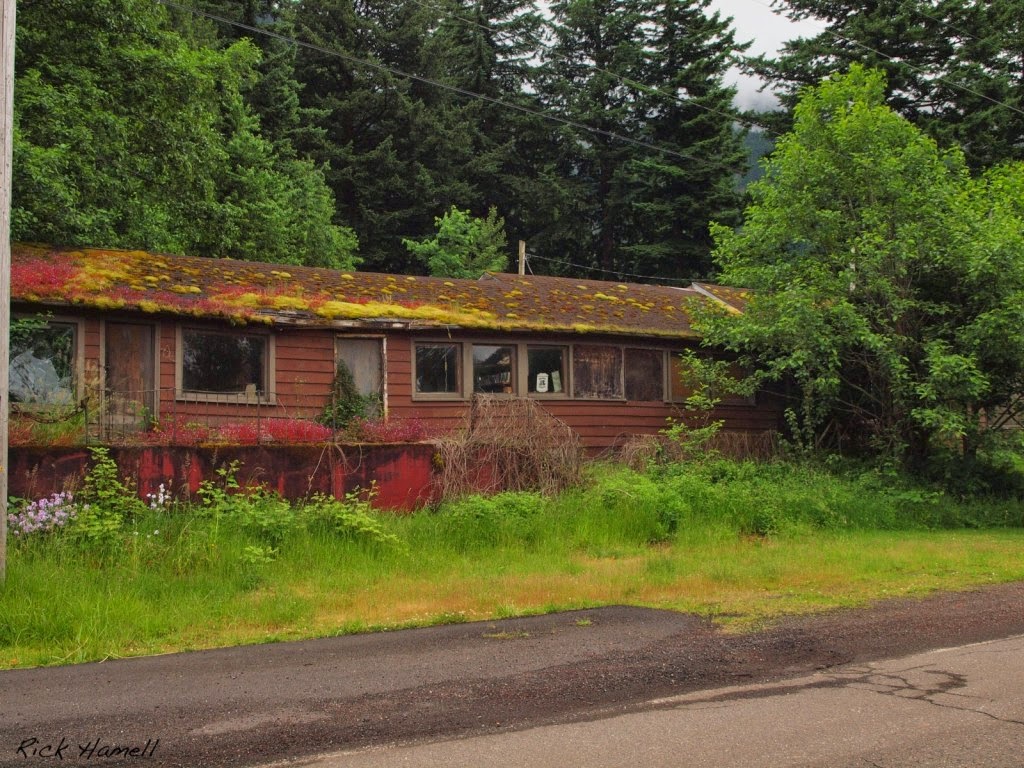Dodson is a small community located between Multnomah Falls and Bonneville Dam on the old Historic Columbia River Highway. There isn't much left of it anymore. At one time, Dodson was a railroad stop on the Union Pacific railway. The town of Dodson was named after Ira Dodson, an early settler and land claimant in the area. Dodson was once the site of the McGowan salmon cannery and fish wheel (1900). Dodson has a boat launch on the Columbia River.

 Dodson Station
Dodson Station
In it's day, Dodson had a motel, service station, a combination store/cafe, a school and several large dairy farms. The Dodson motel consisted of 10 units. To the east of the motel was a cafe and a grocery store. The gas station and the cafe were adjacent to each other and were often owned and/or operated by a "Mom and Pop". There was a school in Dodson (Bonneville Grade School), but it closed in 1996 because of a mud slide and declining enrollment.
The main significance of this small town is historical. It is a vanishing stop located on the Historic Columbia River Highway and like many of the other stops, it is fading into oblivion.
Pictured below is the Bonneville Motel, located in Dodson.

The Bonneville Motel was owned and operated by Oliver H Jones for about 2 decades thru the 40's and 50's. The motel sign still stands near old Hwy 30 in Dodson.

Pictured below is the Dodson store with attached living quarters.
Picture below taken Sept 1, 2014
I had the pleasure of stopping into the store once when I was a kid. I remember walking up the steps and going in there to buy a candy bar. The store was not busy and had just some basic things, food, soda pop, beer, chips and probably cigarettes. The inside was dated and kinda run down. Looking at the picture above, you would enter the store thru the door on that was located on the front left.
Stories from Highway Travelers
Story from Jeff: "I was fishing with my Step Dad for sturgeon over on the Columbia River
at Bonneville. It was 1975. We didn't catch anything and my Step Dad drove us over
to the Dodson store to buy some things. He was low on money and wanted some beer (Heidelberg) and cigarettes (Kool's). He had obviously been out to this place before because he put the beer and cigarettes on his tab and left his fishing pole in the store window for collateral! The store owner didn't have a problem letting him do this. I think he had done it a few times before. Never forget that one."
A while back (2011), someone broke out the front window of the store. This picture was taken before they boarded it up with plywood. Interesting look inside. Notice the cash register in the corner. This was probably the store and the motel business office.
It looks like one of the last things they did was try to sell everything. There is a sign that says: "your choice $15". Also there are price tags on some of the other things in there.
Pictured below is the fish wheel that was once located in Dodson (1900)

Dodson's service station now sits abandoned.
This station was a Flying A service station in the 60's
Picture above taken Sept 1, 2014
The motel sign still stands today.

The completion of the new "water grade" freeway in the early 1950's spelled the end for Dodson Station. The new freeway not only bypassed their business but it created fast and easy access to Portland. In addition, it led to new business opportunities at the freeway interchanges and off ramps. This was a death sentence for the Dodson gas station and motel. They kept it open into the 1970's but it was a losing battle once the new freeway took away most of their customers.
Bonneville Grade School
School was six miles west in the community of Dodson. Bonneville Grade
School -- eight grades in four classrooms -- never had an enrollment of
more than 70 or so students, most of whom lived at the dam.
High school
students went to either Cascade Locks or Stevenson. The school closed in 1996, its enrollment down to 11 students, its
building heavily damaged by landslides caused by severe winter weather. When the 1996 mudslides took place, the school was compromised. The Bonneville School was later sold and currently is used as a storage facility.
Bucher Dairy Farm
Picture of barn in Oct 2007
The Hollywood Dairy was owned by Joe Bucher and his family. Purchased in 1929, the 750 acre dairy provided milk for over 40 years to the Dodson and surrounding communities. At it's peak, the dairy had a herd of 70-80 cows and produced 1200 quarts of milk a day. The large barn was a landmark in the Dodson area. Built in the early 1900's, the barn stood for about 100 years. Sadly, the barn came down in 2010 and is gone.
At one time, Dodson was a railroad station named "Dodson's".
Dodson Landslide
On February 8, 1996 a massive
landslide gave way on the south side of the valley. Actually it began
the day before with slides coming down all over the gorge. It had been
raining hard for several days. The snow had melted at the top of the
cliff which was unusual, adding even more water. Around
noon on February 8th, a 2,000 feet vertical cliff gave way. The earth
shook as the huge wall of mud, water, rocks and trees roared down toward
Carol & Hersh Royse’s farmhouse on the frontage road along Highway
84. They ran out in the front yard, crawled through the board fence and
down through the field to the frontage road.
The
slide engulfed the farmhouse, filling the basement and first floor with
water, mud and rocks up to the kitchen counter tops and tore out the
living room on the west side. It pushed their earth stove about 100
feet out in front of the house. Four to 15 feet of mud, boulders and
trees completely covered their property down to the Frontage Road.
Potential Historic Sites in Dodson:
Bucher's Farm
Dodson Motel
Former Sherman's Inn Tavern
Mountain Shadow Cottages
If you have any info or a story you would like to share, please email me at: rumblefish351@aim.com
Thanks for stopping by!















































.svg.png)








